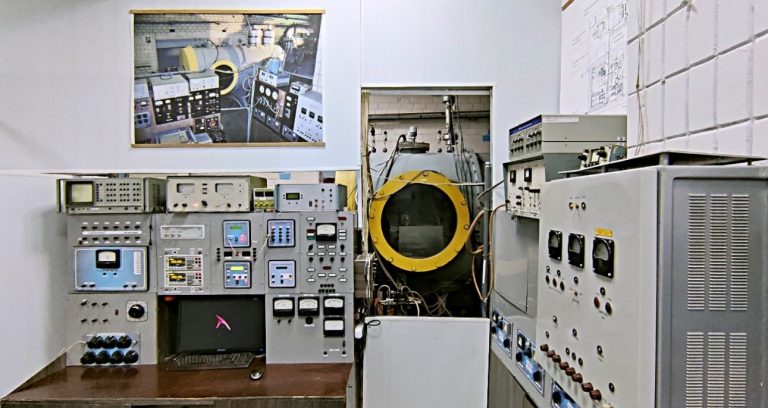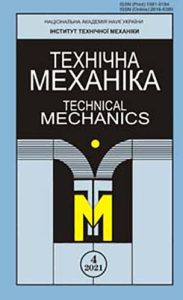Department of ionized media mechanics
Head of department – D.Sc., Professor V. O. Shuvalov

Key specifications
The bench is a plasma gas-dynamic tunnel.The 100 m³/s evacuation system of the bench and its cryopanels cooled with liquid nitrogen produce a static vacuum of 10-5 N/m2² in the work chamber, which is a nonmagnetic steel cylinder of diameter 1.2 m and length 3.5 m — with gas inleakage, the chamber pressure is 10-4 — 10-2 N/m2. Supersonic rarefied plasma flows are produced using a hot-cathode gas-discharge accelerator, whose working medium is ionized by electron impact and electron oscillation in an external magnetic field. The plasma flow parameters are measured using a system of electrical and pressure probes, 5.45 and 9.8 GHz interferometers, and a МХ7303 mass-spectrometer. The diagnostic instruments and models under study are placed on the movable platforms of the upper and lower coordinate tables with four degrees of freedom each. The positioning is checked using potentiometric pickups. The positioning accuracy is — 0.5 · 10-3 m for linear displacements and — 0.5 ° for angular ones.
Description
The plasmoelectrodynamic bench serves to study various aspects of interaction between a solid body (e.g. spacecraft materials and structural elements) with its environment in the Earth ionosphere and magnetosphere. The bench systems and capabilities allow one to simulate the interaction of the planets of the Solar System, artificial bodies, and spacecraft with the interplanetary medium (solar wind), cold ionospheric and hot magnetospheric plasma flows, charged-particle streams, electric and magnetic fields, and solar-spectrum and radar-range electromagnetic radiation in high-elliptical, geostationary, low, medium, and geopolar orbits at altitudes of 150 to 40,000 km.
The plasmoelectrodynamic bench is the National Treasure according to the Cabinet of Ministers of Ukraine’s order #650 from 28/08/2013.
Capabilities
- contact diagnostics of the neutral and charged components of high-speed flows of nonequilibrium collisional and collisionless partially dissociated plasma in the pressure range 103 down to 10-9
- study of the acceleration mechanisms and flow pattern for plasma bunches and steady and pulse plasma jets expanding into vacuum; revealing the effects and mechanisms of attenuation and distortion of radio signals reflected from spacecraft elements in the centimetric, decimetric and metric wave bands by the plasma jets and artificial plasma formations produced in the vicinity of the spacecraft surface as a result of the operation of electrojet engines, electron beam injection, and passive and active in-orbit experiments;
- simulation and study of the processes, mechanisms, and regularities of accumulation and neutralization of high-voltage charges during the exposure of dielectric materials and spacecraft surface coatings to electromagnetic radiation and high-energy electrons of the Earth radiation belts in a geostationary orbit and to auroral electrons when the spacecraft is in a supersonic flow of cold plasma in the polar ionosphere;
- physical-chemical simulation and study of solar battery power degradation and the behavior of the weight, geometrical, and thermooptical characteristics of solar battery polymer and composite materials during long-term exposure to a complex of space factors in a geostationary orbit and to a supersonic flow of atomic oxygen and ultraviolet radiation in the Earth atmosphere;
- physical simulation of the effects and regularities of magneto-hydrodynamic interaction of magnetized bodies with a rarefied plasma flow;
- aerodynamics and heat exchange of spacecraft and their structural elements in a rarified plasma flow.
Comparison with existing analogs
The plasmoelectrodynamic bench combines the features of a plasma gas-dynamic tunnel, an electroradiation bench, and a vacuum anechioc chamber. In this sum of features and the range of scientific and tecnical problems it solves, the bench is unparalleled.
The punblished results of investigations illustrate the capabilities of the plasmoelectrodynamic bench:
- Shuvalov V. A. Structure of bunches and jets of a plasma pulse expanding into vacuum (in Russian) / V. A. Shuvalov, M. G. Bystritskii, G. S. Kochubei, A. E. Churilov // Teplofizika Vysokikh Temperatur. – 2004. – N. 42, No 1. – Pp. 23 – 30.
- Shuvalov V. A. Molecular contamination of the spacecraft surface in thermostating and orbital injection (in Russian) / Shuvalov V. A., Tikhii V. G., Potapovich L. P., Priimak A. I., Pismennyi N. I., Kochubei G. S. // Kosmichna Nauka i Tekhnologiya. – 2007. – V. 13, No 3. – Pp. 3 – 11.
- Shuvalov V. A. Probe diagnostics of high-speed flows of partially dissociated rarefied plasma (in Russian) / V.A. Shuvalov, N. I. Pismennyi, A. I. Priimak, G. S. Kochubei // Pribory i Tekhnika Eksperimenta. – 2007. – No 2. – Pp. 92 – 100.
- Shuvalov V. A. Behavior of spacecraft solar panel materials exposed to atomic oxygen (in Russian) / V. A. Shuvalov, G. S. Kochubei, A. I. Priimak, N. I. Pismennyi , N. A. Tokmak // Kosmicheskie Issledovaniya. – 2007. – V. 45, No 4. – Pp. 294 – 304.
- Shuvalov V. A. Magnetodynamic braking of the “magnetized” planets in a solar wind plasma flow (in Russian) / Shuvalov V.A. Bandel K. A., Priimak A. I., Kochubei G. S. // Kosmichna Nauka i Tekhnologiya. – 2009. – V. 15, No 6. – Pp. 3 -13.
- Pismennyi N. Physical modeling of interaction of spacecraft with near-satellite environment / Pismennyi N., Priimak A., Nosikov S., Tsokur A. // Space Research in Ukraine 2006 – 2008 / National Space Agency of Ukraine. – Kiev, 2008. – Pp. 101– 106.
- Shuvalov V. A. Charge transfer by fast electrons onto the leeward surfaces of a solid body in a supersonic rarefied plasma flow (in Russian) / Shuvalov V. A., Priimak A. I., Bandel K. A., Kochubei G. S. // Prikladnaya Mekhanika i Tekhnicheskaya Fizika. – 2008. – V. 49, No 1. – Pp. 13 – 23.
- Shuvalov V. A. Diagnostics of the neutral and the charged component of a rarefied plasma flow with calorimetric probes (in Russian) / V. A. Shuvalov, D. N. Lazuchenkov, G. S. Kochubei, S. V. Nosikov // Pribory i Tekhnika Eksperimenta. – 2010. – No 3. – Pp. 80 – 87.
- Shuvalov V. A. Diagnostics of nonequilibrium collisional plasma with a hot-wire anemometer probe (in Russian) / V. A. Shuvalov, G. S. Kochubei, D. N. Lazuchenkov // Teplofizika Vysokikh Temperatur. – 2011. – V. 48, No 1. – Pp. 28 – 35.
- Shuvalov V. A. Control of the heat exchange and braking of a “magnetized” body in a rarefied plasma flow (in Russian) / V. A. Shuvalov, A. I. Priimak, K. A. Bandel, G. S. Kochubei, N. A. Tokmak // Teplofizika Vysokikh Temperatur.. – 2011. – V. 48, No 3. – Pp. 1-10.
- Shuvalov V. A. Heat exchange and braking of a “magnetized” body in a rarefied plasma flow (in Russian) / V. A. Shuvalov, A. I. Priimak, K. A. Bandel, G. S. Kochubei, N. A. Tokmak // Prikladnaya Mekhanika i Tekhnicheskaya Fizika. – 2011. – V. 52, No 1. – Pp. 1 – 14.

